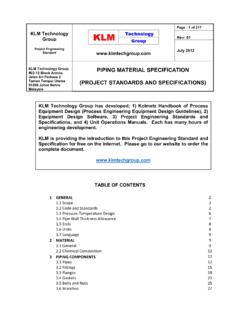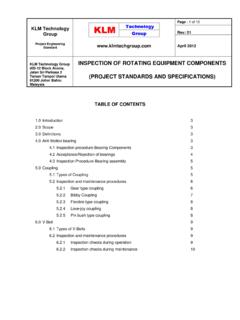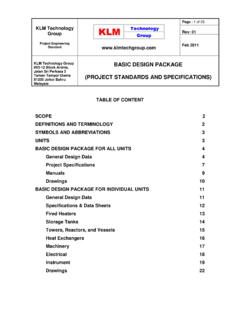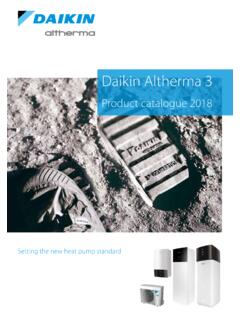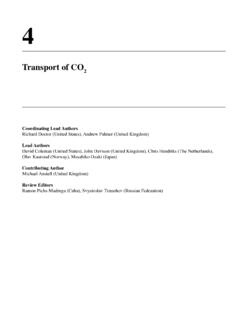Transcription of PROCESS DESIGN OF GAS (VAPOR)-LIQUID SEPARATORS …
1 KLM TechnologyGroupProject :1of45 Rev: 01 April2011 KLM Technology Group#03-12 Block Aronia,Jalan Sri Perkasa 2 Taman Tampoi Utama81200 Johor BahruMalaysiaPROCESS DESIGNOF GAS (VAPOR)-LIQUIDSEPARATORS(PROJECT STANDARDS AND SPECIFICATIONS)TABLE OF CONTENTSCOPE2 REFERENCES2 DEFINITIONS AND TERMINOLOGY2 SYMBOLS AND ABBREVIATIONS4 UNITS6 GENERAL6 Gas-Liquid Separators6 Separation Mechanisms6 General Notes on Separator Piping7 Separator Material8 CONVENTIONAL GAS/LIQUID SEPARATORS8 General8 DESIGN Criteria9 Specification Sheet20 Oil/Gas Separators21 CENTRIFUGAL GAS/LIQUID SEPARATORS23 General23 Cyclone Separators24 FLARE KNOCK-OUT DRUMS28 General28 GAS/LIQUID FILTER SEPARATORS28 General28 DESIGN Criteria31 Specification Sheet33 APPENDIX A34 APPENDIX B35 APPENDIX C36 APPENDIX D37 APPENDIX E39 APPENDIX F42 APPENDIX G43 KLM TechnologyGroupProject Engineering StandardPROCESS DESIGNOF GAS (VAPOR)-LIQUID SEPARATORS (PROJECT STANDARDS ANDSPECIFICATIONS)Page2of45 Rev.
2 01 April2011 SCOPEThis Project Standards and Specificationscovers minimum requirements for theprocess DESIGN (including criteria for type selection) of gas (vapor)-liquidseparators used in the production of the oil and/or gas, refineries and other gasprocessing and petrochemical plants. For the purpose of this Standard,separation techniques are defined as, those operation, which isolate specificimmiscible ingredients of a mixture mechanically, , without a chemical reactionor a mass transfer PROCESS taking this Standard the following dated and undated standards/codes arereferred to. These referenced documents shall, to the extent specified herein,form a part of this standard. For dated references, the edition cited applies. Theapplicability of changes in dated references that occur after the cited date shallbe mutually agreed upon by the Company and the Vendor.
3 Forundatedreferences, the latest edition of the referenced documents (including anysupplements and amendments) (American Society of Mechanical Engineers)ASME Section VIII, Boiler and Pressure Vessel, Code . Edition 2007 (AmericanPetroleum Institute)API Spec. 12J"Specification for Oil and Gas SEPARATORS ", 7th. Ed., 510 Pressure Vessel Inspection, Code: In Service Inspection,Rating, Repair, and Alteration . 9th Ed., June AND TERMINOLOGYC oalescer-A mechanical PROCESS vessel with wettable, high-surface areapacking on which liquid droplets consolidate for gravity separation from a secondphase (for example gas or immiscible liquid).Control Volume-A certain liquid volume necessary for control purposes and formaintaining the velocity limit requirement for degassing and to counter foam TechnologyGroupProject Engineering StandardPROCESS DESIGNOF GAS (VAPOR)-LIQUID SEPARATORS (PROJECT STANDARDS ANDSPECIFICATIONS)Page3of45 Rev: 01 April2011 Conventional Gas-Liquid Separator-In this Standard, the term "ConventionalGas-Liquid Separator" is referred to vertical or horizontal SEPARATORS in which gasand liquid are separated by means of gravity settling with or without a misteliminating is defined as the destruction of a metal by chemical orelectrochemical reaction with its (Mist Extractor)-A device installed in the top of scrubbers, SEPARATORS , tray or packed vessels, etc.
4 To remove liquid droplets entrained in aflowing gas Height-The height provided between bottom of the wire-meshpad and liquid levelof a vapor-liquid Filter-Commonly termed "bag filters" or "baghouses", are collectors inwhich dust is removed from the gas stream by passing the dust-laden gasthrough a fabric of some Tank-A vessel used to separate thegas evolved from liquid flashed froma higher pressure to a lower Time-A time period during which the amount of liquid separated in agas-liquid separator is actually in the vessel for the purpose of control or separator used for a bulk separation of gas and liquid. It falls intoone of two categories as below:a)The free water knock-out is a vessel used to separate free water from a flowstream of gas, oil, and water. The gas and oil usually leave the vessel throughthe same outlet to be processed by other equipment.
5 The water is removedfor )The total liquid knock-out is normally used to remove the combined liquidsfrom a gas Drip-A device typically used in pipelines with very high gas-to-liquid ratiosto remove only free liquid from a gas stream,and not necessarily all the Allowable Working Pressure-The maximum allowable workingpressure (MAWP) is the maximum pressure, permissible by the ASME Code atKLM TechnologyGroupProject Engineering StandardPROCESS DESIGNOF GAS (VAPOR)-LIQUID SEPARATORS (PROJECT STANDARDS ANDSPECIFICATIONS)Page4of45 Rev: 01 April2011the top ofthe separator in its normal operating position for a Pressure-The operating pressure is the pressure in the vesselduring normal operation. The operating pressure shall not exceed the MAWP,and is usually kept at a suitable level below the setting of the pressure relievingdevices to prevent their frequent type of separator which has been designed to handle flow streamswith unusually high gas-to-liquid ratios.
6 These are commonly used in conjunctionwith dehydrators, extraction plants, instruments, or compressors for protectionfrom entrained Catcher-A particular separator DESIGN able to absorb sustained in-flow oflarge liquid volumes at irregular Efficiency-The fraction of particles or droplets in the entraining fluid of aseparator, moving past an object in the fluid, which impinge on the Velocity or Drop-Out Velocity-The velocity at which a particle ordroplet will fall under the action of gravity, when drag force just balancesgravitational force and the particle (or droplet) continues to fall at Space-The volume of a vapor liquid separator above the liquid area for gas flow, (m ).aLength of side, square cyclone inlet, (type 1), (m).CDrag coefficient of particle or droplet, (dimensionless).
7 DfFilter element outside diameter, (m).DpDroplet or particle diameter, (m).DvInternal diameter of a separator vessel, (m).dnNozzle diameter, (m).dn1 Feed nozzle (m)dn2 Gas outlet nozzle (m)dn3 Liquid outlet nozzle (m)d1 Internal diameter of feed inlet, (m).d2 Internal diameter of gas outlet, (m).d3 Diameter of cylindrical cyclone baffle, (m).KLM TechnologyGroupProject Engineering StandardPROCESS DESIGNOF GAS (VAPOR)-LIQUID SEPARATORS (PROJECT STANDARDS ANDSPECIFICATIONS)Page5of45 Rev: 01 April2011gLocal acceleration due to gravity, (m/s ).HHeight, (tangent to tangent) of vessel, (m).HcHeight of cyclone (from bottom plate to outlet pipe),(m).hHeight of vessel required for hold-up, (m).KEmpirical constantfor separator sizing, (m/s).KCRP roportionality (L)Level Alarm (Low)LA (H)Level Alarm (High)LfFilter element length, (m).LvLength of a horizontal separator vessel, (tangent totangent), (m).
8 MgMass flow rate of gas, (kg/s).MlMass flow rate of liquid, (kg/s).PinPressure at inlet, (kPa).PoutPressure at outlet, (kPa).QVolumetric load factor, (m /s).QgVolumetric flow rate of gas, (m /s).QlVolumetric flow rate of liquid, (m /s).QmaxMaximum value of Q, (m /s).RRadius of cyclone scroll f, (m).ReReynolds number, (dimensionless).sWidth of split between cyclone bottom plate and wall,(m).TTime (min).tThickness of demister pad, (m).VcCritical gas velocity necessary for particles to drop orsettle, (m/s).Vg,inGas velocity at inlet, (superficial), (m/s).Vg,outGas velocity at outlet, (m/s).VmMixture velocity at inlet = (Qg + Ql)/( dn /4), (m/s).VtTerminal or free settling velocity of particle or dropletand terminal rising velocity of bubbles, in liquid phase,(m/s). l(gamma)Liquid kinematic viscosity, cSt(mm /s) (mu)Dynamic viscosity of continuous phase, cP( ).
9 G(mu)Dynamic viscosity of gas, cP ( ). g(rho)Gas phase density, (kg/m ). l(rho)Liquid phase density, (kg/m ). m(rho)Mixture density at inlet = (Mg+Ml)/(Qg+Q), (kg/m ).KLM TechnologyGroupProject Engineering StandardPROCESS DESIGNOF GAS (VAPOR)-LIQUID SEPARATORS (PROJECT STANDARDS ANDSPECIFICATIONS)Page6of45 Rev: 01 April2011 UNITSThis Standard is based on International System of Units (SI) except whereotherwise SEPARATORS can be generally divided into twomain groups, high gasto liquid ratio ( flare knock-out drums, scrubbers), and low gas to liquid ratio( oil/gas SEPARATORS , flash tanks) SEPARATORS . In this Standard, processaspects of three types of most frequently used gas (vapor)-liquid SEPARATORS arediscussed more or less in details, these three types are:-Conventional gas-liquid SEPARATORS (including oil/gas SEPARATORS ).
10 -Centrifugal gas-liquid filter of mechanical SEPARATORS are generally shown inFig. of Appendix SeparatorsGas-liquid separator types often used in processes which are discussed in thisStandard are:-Conventional Gas/Liquid Knock-out MechanismsGas-liquid separation processes most frequently employed in industries arebased on either one or a combination of "Gravity Settling", "Impingement" and"Centrifugation", mechanisms. Some types of "Filtration" are seldom employed inthis field. The principles of mechanical separation in general, can be classified asmomentum, gravity and filtration that are briefly described in the followingsections. Note that as a general rule, mechanical separation occurs only whenthe phases are immiscible and have different TechnologyGroupProject Engineering StandardPROCESS DESIGNOF GAS (VAPOR)-LIQUID SEPARATORS (PROJECT STANDARDS ANDSPECIFICATIONS)Page7of45 Rev: separation by momentumFluid phases with different densities will have different momentum.

